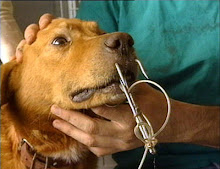Experts Agree Dog Whispering Results in Bites
Dog training and behavior experts agree the popular dominance-based methods employed and recommended by many dog trainers featured on television result in an increased risk of dog bites.
Halifax, Nova Scotia (PRWEB) May 15, 2009 -- As Dog Bite Prevention week is recognized across the United States, one of the contributing factors to this seeming epidemic may require Americans turn off their TVs.
According to the Centers for Disease Control and Prevention, close to five million Americans are bitten by dogs annually with approximately 1,000 people requiring emergency medical attention every day. A key factor in aggressive dog behavior is the way they are trained. Experts agree the dominance-based techniques often used on popular programs increase the risk of aggression and dog bites. Adina MacRae, President of the Clicker Leash Co., inventor of a new positive dog training tool, says this is why she brought her humane training system to market. "I have seen first-hand the results of dominance-based training methods and they can be scary," says MacRae. "The majority of dogs bite out of fear and the techniques you see on most television shows are designed to suppress undesirable behaviors with scare tactics." MacRae, a dog trainer known for using positive reinforcement to help dogs overcome aggression, noticed as the popularity of dominance-based training grew, she was getting more calls about growling, snapping and biting dogs. She points to the disconnect that often occurs when people try to take on an "alpha" role instead of being a guardian to their companion animals resulting in dogs becoming defensive.
MacRae is not alone in her experience. Most recently, the journal of Applied Animal Behaviour Science published the results of a year-long University of Pennsylvania study illustrating the risks of aggressive training. It was discovered that "alpha rolls," where dogs are rolled onto their backs and held there, and "dominance downs," where dogs are physically forced onto their sides, resulted in an aggressive response from at least 25 per cent of the surveyed group.
The study's findings are backed by a 2008 American Veterinary Society of Animal Behavior (AVSAB) position statement on the use of dominance in animal training. The AVSAB recommends veterinarians not refer patients to trainers who adhere to dominance hierarchy theory and the confrontational training that typically results. The society went on to recommend the use of positive reinforcement to safely train animals. Joan Orr of Doggone Safe, a non-profit organization dedicated to dog bite prevention through education, recommends clicker training as a hands-off way of training a dog while reducing the risk of bites.
Friday, May 15, 2009
Subscribe to:
Post Comments (Atom)

















No comments:
Post a Comment